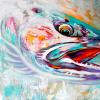I was recently fortunate enough to find a Stanley No. 92 shoulder plane within my meager price range. However, like most planes that are in my price range, it isn't exactly in mint condition. About 1/3 of the nickel plating is worn off and most of what is left is in bad shape. The harder-to-reach areas have some rust that I'm not gonna get to with any mechanical methods. The sole is also not quite flat and the sides are pretty square but not perfect. So, by the time I get it cleaned and tuned it'll have even less nickel plating and thus becomes a prime candidate for a full refinish.
I've painted planes in the past but I've been itching to try some other finish methods and now I have an excuse. Ideas so far:
-Rust bluing. No, not Brownell's oxpho-blue or any other cold blue. I mean the real thing--rust bluing that is generally only done on high-end firearms anymore. It's an easy enough process that I could definitely do it myself, though I haven't before. It wouldn't be entirely rust-preventing but it would help, it would not interfere with any tolerances or the smooth sliding of the sides against wood, and it could be very aesthetically pleasing.
-Next idea: Phosphate rust converter. This one seems simple and effective, but I would have to polish/sand it off the sides and the sole because it wouldn't make for a nice smooth surface.
-Ceramic coatings: These are most commonly used on guns. Examples are Cerakote and Duracoat. I have a rifle that was Duracoated, and it is definitely a more durable finish than any bluing or paint I've seen. Plus it is entirely rustproof so maintenance is minimal. That all said, it isn't quite as smooth as bluing and it does build a little bit in thickness so any metal parts that are mated together will either not get coated or the coating will be removed whether it be through sanding or just through use. Still, it would probably be the lowest-maintenance option and it would look just as good as any paint probably would.
Right now I'm leaning towards rust bluing because I think it will provide the smoothest surface (assuming proper prep) and thus the best function. It might also look kinda cool and unique.
Has anyone experimented with any of these finishing methods? Is there any good reason to avoid playing with any of these?
Thanks!





 Reply With Quote
Reply With Quote

